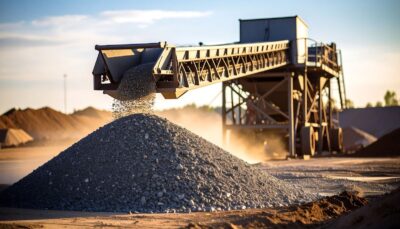Efficient material movement forms the backbone of successful quarry, mine, and processing operations, where every ton of material counts toward productivity and profitability. Conveyor systems are central to keeping operations moving smoothly, handling large volumes with consistency and precision. When conveyors are poorly designed, operations can face costly downtime, excessive wear on equipment, and increased risks to worker safety.
Tailored conveyor design services address these challenges, providing systems engineered for specific site conditions, material types, and operational goals. From aligning equipment for optimal flow to incorporating advanced technologies that support long-term performance, professional design can make a measurable difference.
Read on to discover how conveyor design services can elevate efficiency, safety, and cost-effectiveness across your mining and processing operations.
1. Enhancing Material Handling Efficiency
A well-planned conveyor system can transform how materials move across a quarry, mine, or processing plant. Thoughtful design minimizes delays, streamlines operations, and improves overall throughput.
The following are the areas where professional design makes a significant difference:
- Optimized layouts: Custom conveyor paths reduce unnecessary transport distances and eliminate sharp turns or complicated transfer points. This ensures materials move smoothly between extraction, crushing, and processing stages while minimizing energy use and wear on the system.
- Automated controls: Smart sensors, load monitoring, and adjustable speed systems allow conveyors to respond to varying loads in real time. Crush & Screen WA or another expert firm can design automation strategies that balance material flow, prevent overloading, and synchronize multiple conveyors efficiently. This reduces the need for constant manual adjustments and keeps production steady.
- Reduced bottlenecks: Properly engineered transfer points, chutes, and merging systems prevent material pileups or interruptions at critical stages such as crushers, screens, and feeders. This leads to fewer stoppages, smoother operations, and increased processing capacity.
Investing in professional conveyor design ensures materials move efficiently from one stage to the next, improving throughput, reducing handling delays, and supporting overall operational reliability.
2. Improving Safety and Compliance
Ensuring a safe working environment is a critical priority for any quarry, mine, or processing facility. Thoughtful engineering design of conveyor systems integrates safety measures directly into the operation, reducing the risk of accidents while supporting consistent productivity.
The following are essential ways conveyor design services strengthen safety and compliance:
- Guarding and access points: Properly designed platforms, walkways, and guards around belt conveyors, roller conveyors, and custom conveyors protect workers from moving parts while allowing easy access for inspection and maintenance. Clear access points reduce workplace hazards and support safer day-to-day operations.
- Dust and spillage control: Enclosed conveyor equipment, optimized chute design, and effective load zone chute transfer points limit airborne dust and material spillage. This improves air quality, protects machinery from damage, and reduces slips, trips, or other workplace incidents.
- Regulatory compliance: Systems are designed to meet OSHA, MSHA, and other local safety standards. Using precise component specifications and material handling solutions ensures the facility adheres to regulations without compromising maximizing efficiency or throughput.
Investing in safety-focused material handling systems creates a more reliable operation, safeguards employees, and reduces the likelihood of costly incidents. Well-designed conveyor systems support both compliance and operational continuity, allowing teams to work with confidence.
3. Reducing Maintenance and Operating Costs
A well-planned conveyor system lowers the frequency of unexpected breakdowns, which can disrupt operations and lead to costly repairs. Carefully selected components and materials extend the life of the system, reducing the need for frequent replacements. This approach ensures that equipment continues to perform reliably over time, helping operations stay on schedule and within budget.
Furthermore, strategic design choices simplify maintenance procedures, allowing technicians to perform inspections and repairs with minimal disruption. Modular sections and easy-access points make it faster to replace worn parts, while clear layouts reduce the time required for routine upkeep. As a result, staff can spend less time troubleshooting and more time supporting productive operations.
In addition, energy-efficient systems contribute to long-term cost savings by lowering power consumption and minimizing waste. Variable-speed drives and intelligent control systems optimize energy use without affecting throughput.
4. Supporting Scalability and Future Expansion
As operations grow, conveyor systems must adapt to accommodate increased material volumes and evolving processing requirements. Thoughtful planning ensures that expansions can be implemented without major disruptions to ongoing operations. This foresight reduces the need for costly retrofits and maintains consistent throughput during periods of growth.
Moreover, modular system designs allow facilities to reconfigure, add, or relocate conveyor sections with ease. This flexibility supports gradual expansion and makes it simpler to integrate new production lines or equipment. Facilities can respond to market demands efficiently without overhauling the existing layout.
In addition, incorporating technology that enables remote monitoring and data analysis prepares operations for smarter management over time. These systems provide insights into performance trends, helping identify bottlenecks or areas that may require upgrades before they become critical.
Final Thoughts
Investing in expertly designed conveyor systems creates a foundation for operational excellence that extends beyond immediate productivity gains. Thoughtful engineering enhances material flow, reduces operational strain, and positions facilities to adapt efficiently as demands change. These systems foster safer work environments, lower long-term costs, and provide the flexibility to integrate new technologies without disruption.
View the original article and our Inspiration here


Leave a Reply